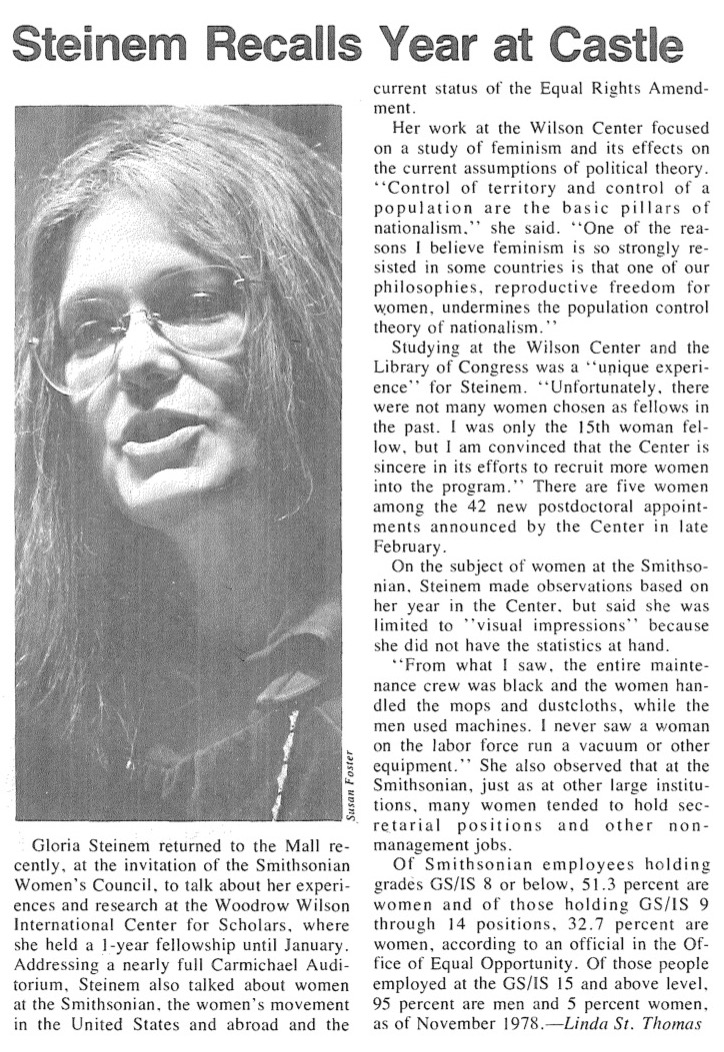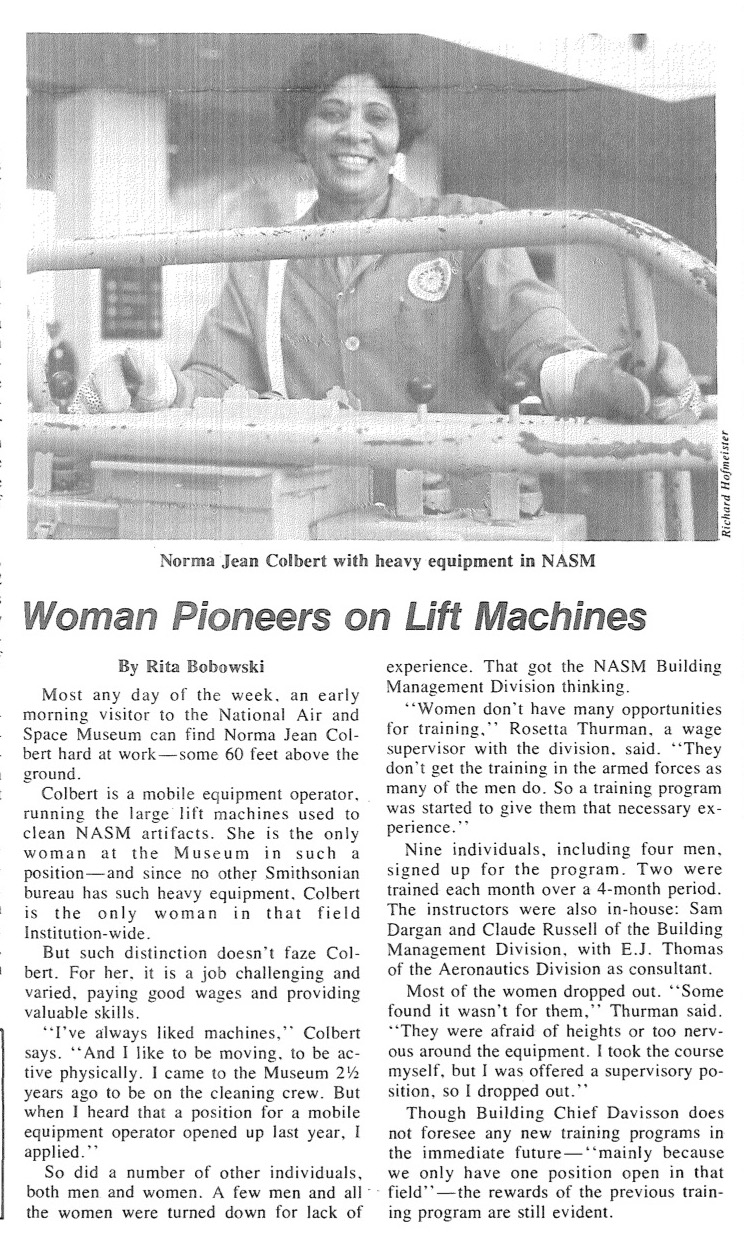In December 1978, Gloria Steinem met with the Smithsonian Institution Women’s Council (SIWC) to advise the group on carrying out the work of change at the Smithsonian and to broaden members’ understanding of the women’s movement. As described by attendees, the conversation was “dynamite…great…wonderful.” One member expressed her surprise at finding Steinem so agreeable; Steinem was nothing like what she expected—she was “radiant!”
The meeting went so well, in fact, the SIWC invited Steinem back for an encore. In the spring of 1979, she returned to the Smithsonian to deliver the lecture, “The Women’s Movement Today.” The talk is referenced in the Smithsonian’s 1979 annual report and was covered by the Smithsonian’s employee newspaper, The Torch.

Steinem had been interacting with Smithsonian staff in the late ‘70s while she held a one-year fellowship from 1977 to 1978 at the Woodrow Wilson International Center, which operated out of the Smithsonian Institution Building, often known as the Castle. At the Wilson Center, Steinem’s research focused on feminism and political theory. Although she was dashing back-and-forth between New York and D.C. to run Ms. magazine and fulfill her duties as a fellow, Smithsonian Institution Archives’ records show that many members reached out to Steinem for advice and to discuss the status of women at the Smithsonian.
These records documenting the SIWC members’ interactions with Steinem are revealing, as they highlight some of the struggles that women were facing at the time. For example, anthropologist Joanna Cohan Scherer reached out to Gloria Steinem confidentially in 1978 to thank her for taking time to chat and to offer to provide her with more information about “S.I practices.” As a previous blog has discussed, Scherer worked in anthropology at the Smithsonian Office of Anthropology Archives (now the National Anthropological Archives) and, in 1975, won a class action and employment discrimination suit on the basis of gender against the Smithsonian. Scherer hoped as Steinem’s fellowship came to an end, she might be willing to “speak out about women’s situation here.” In fact, at the time of their correspondence, Scherer was in the midst of a reprisal complaint against the Smithsonian that was heard in the U.S. District Court for the District of Columbia (Scherer vs. Ripley, CA 77-1856). In 1982, the court determined that management had engaged in numerous incidents of reprisal against Scherer and found in her favor. To learn more, see the Archives’ Joanna Cohan Scherer Papers, 1960-2014.
In another instance, SIWC Chairperson Rosemary M. DeRosa described the SIWC’s challenges to Steinem in a December 13, 1978 letter. She wrote:
Our largest practical problem concerns using time in an efficient and energetic manner. (Another problem involves the disparate nature or levels, really, of our political and activist sensibilities. Some former Council members used a strong, radical tactic in their dealings with Management concerning Child Care. Those tactics virtually wiped out any possibility of a child care facility being installed here. I do not believe in pussy-footing, either. But, that’s all grist for another letter, maybe.)
Rosemary DeRosa clearly trusted Gloria Steinem. In a November 6, 1978 letter, she reached out to schedule Steinem’s final lecture, and she shared statistics from a draft copy of the Smithsonian’s 1978-80’s Affirmative Action Plan. Although one administrator had told DeRosa that the stats did not reflect recent “vast improvement,” DeRosa believed “these numbers illustrate the situation here in an objective and true light.” DeRosa wrote that she felt comfortable sharing the stats, because they were in the public domain in her estimation.
In her lecture, it seems that Steinem declined to publicly cite these statistics. According to Torch coverage of the event, Steinem said that while she didn’t have stats, after working at the Castle, she had observations to share: “The entire maintenance crew was black and the women handled the mops and dustcloths, while the men used machines.” Steinem also noted that it seemed like many women were in secretarial positions and non-management jobs.
According to the Smithsonian’s Institutional Historian, Dr. Pamela Henson, Steinem’s remarks had real impact at the Smithsonian. Steinem’s comments about maintenance crews revealed that women were likely not operating machinery, because if they did so, they’d be entitled to higher pay. Indeed, quite possibly as a response to this observation, the same issue of the Torch that references Steinem’s remarks features an article highlighting the work of Norma Jean Colbert, the only woman to work as a mobile equipment operator at the Smithsonian. Additionally, ongoing conversations about women in leadership at the Smithsonian persisted. As reported by The Torch in April 1979, according to an official in the Office of Equal Opportunity, only 5% of GS/IS 15 and above positions were held by women at the Smithsonian around 1979. Gloria Steinem’s work with the SIWC helped bring wider attention to these disparities and encouraged staff to keep pressing for change.

Related Resources
- “Steinem Recalls Year at Castle,” The Torch, April 1979
- Institutional History Division, Pamela Henson’s personal notes, Smithsonian Institution Archives
- The Education of a Woman: The Life of Gloria Steinem, by Carolyn G. Heilbrun, The Dial Press: 1995.
- “Women Carrying out the Work of Change in the 1970s,” by Elizabeth Harmon, The Bigger Picture, Smithsonian Institution Archives
- “Gender Discrimination at the Smithsonian Institution,” by Clara Kaul, The Bigger Picture, Smithsonian Institution Archives
Produced by the Smithsonian Institution Archives. For copyright questions, please see the Terms of Use.

Leave a Comment